

 The Jewish cemetery of Březnice also stands in the middle of a huge grain field, surrounded by a wall, along the road from Rožmital to Březnice. Wherever you look, you see only fields, no trace of a settlement.
The Jewish cemetery of Březnice also stands in the middle of a huge grain field, surrounded by a wall, along the road from Rožmital to Březnice. Wherever you look, you see only fields, no trace of a settlement.
More precisely, along the small street that turns off the main road to the cemetery, called U židovského hřbitova, To the Jewish Cemetery, there are two buildings, a renovated farmhouse – called Na Čampulce in 18th-century sources – and an abandoned mill called Nový Mlýn, New Mill, on the banks of the Skalice stream. Between the two there is the stump of a former large multi-branched tree, on which a polar bear family seems to have squatted.
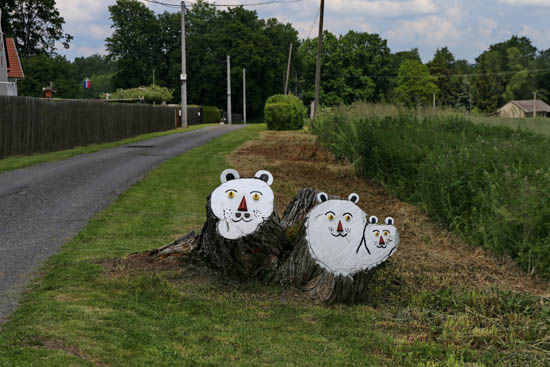
In the cemetery, documented since 1553, the Baroque and 19th and 20th-century tombstones are well separated from each other. The latter stones – grouped around a Neo-Gothic funeral home built in 1893 – have almost all disappeared, their foundations just standing out from the all-embracing ivy. As we will find out later, the granite tombstones were sold by the town to the construction company Stavba Olomouc in the 1980s.

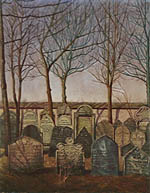 The Baroque tombstones, however – the earliest from the late 17th century – stand in nice rows, just as in the 1923 painting by the Viennese painter Heinrich Bachrich (1868-1935) who died here. The Nazis did not vandalize the cemetery as much as did the Czechoslovakian Communists, who made great sport of the matter, having similarly destroyed the German cemeteries in the area. But there was no market for sandstone and limestone.
The Baroque tombstones, however – the earliest from the late 17th century – stand in nice rows, just as in the 1923 painting by the Viennese painter Heinrich Bachrich (1868-1935) who died here. The Nazis did not vandalize the cemetery as much as did the Czechoslovakian Communists, who made great sport of the matter, having similarly destroyed the German cemeteries in the area. But there was no market for sandstone and limestone.A special feature of these tombstones are the contours shaped with Baroque playfulness, provided with single or triple circle- or heart-shaped additions. As the morning sun shines on their edges, it is as if the rows have drawn the parallel voices of a Baroque piece of music. Most stones only have inscriptions, mostly in full-bodied Baroque typography. Only a few of them are adorned with floral ornaments, and only one has an animal symbol, although this, as we have seen, is very common in Hassidic cemeteries of the period.
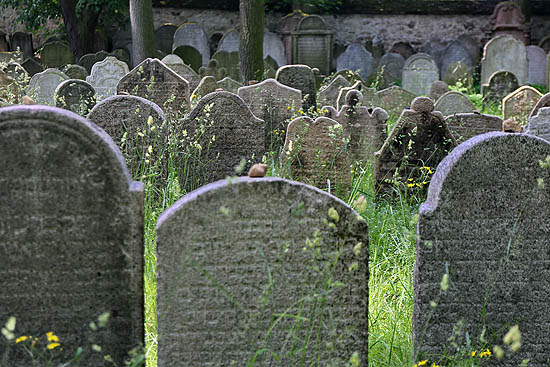

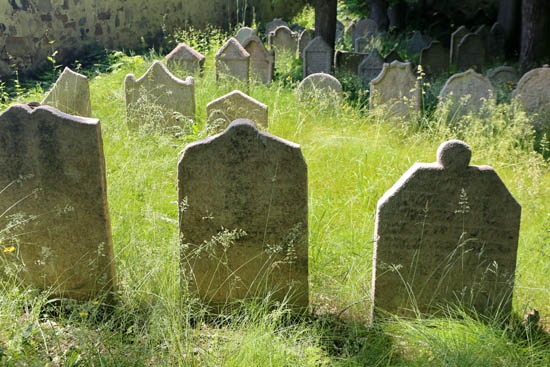

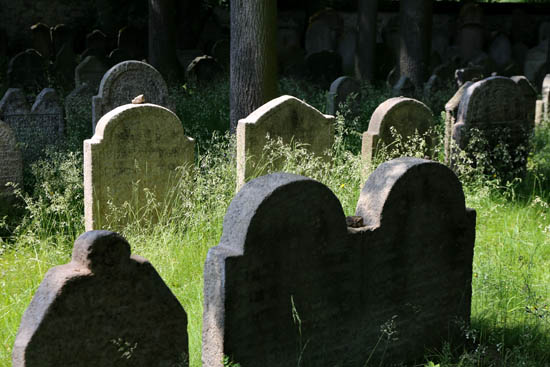
This single animal symbol is the wolf, which refers to the name of the deceased, Benjamin Wolf Popper (1702-1767).
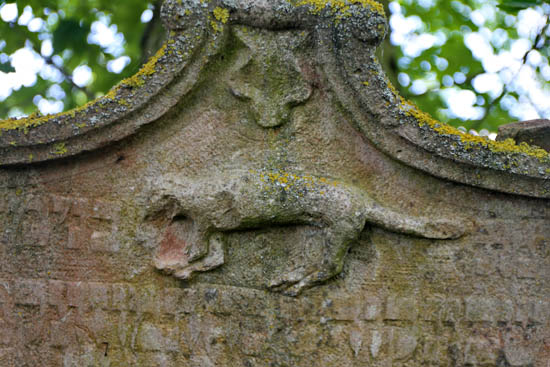
Wolf Popper rose from a local family of craftsmen, merchants and money lenders to become the tax collector and judge of all the rural Jews in Bohemia (Primator der Landesjudenschaft). He was one of the three Jews to whom Emperor Leopold I transferred the Bohemian tobacco monopoly, which provided him with a huge income. His great fortune and good relations were also inherited by his son Joachim Chayim (1730-1795), who became the largest moneylender for the Bohemian nobility and a supplier of the Austrian army during the Seven Years’ War, and who, in 1790, was the second Austrian Jew to receive a noble rank from Joseph II with the title “Edler von Popper” without having to be baptized in exchange. He was a great fighter for the rights of Bohemian Jewry, and during the famine of 1770-1772 he supplied grain to the poor of the town, Christians and Jews alike, at his own expense. However, in 1780 he moved to Prague, where he is buried. Only his father remained in Březnice, whose tomb rises far above the other Baroque tombstones.
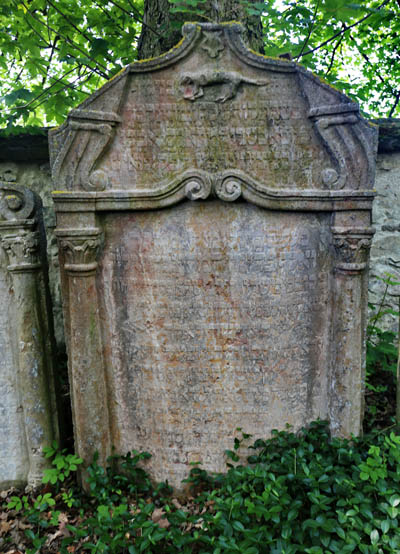
Two other tombstones can also be linked to well-known local personalities. A stone decorated with a rose stands above the tomb of Rabbi Abraham Luria, deceased in 1765, and another with three sephiroths (Kabbalistic emanations of the Divine One) above that of Rabbi Moshe Baruch Muneles, deceased in 1801.

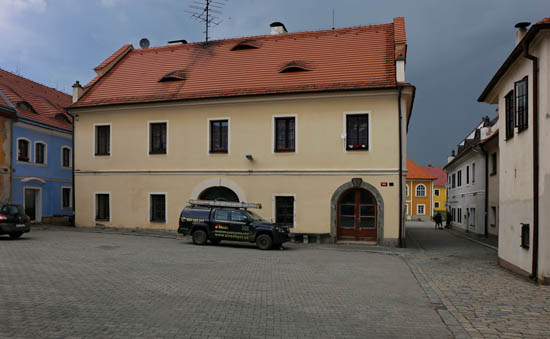 The Popper House in Březnice’s Jewish quarter today (above) and before the war, with the name of Moritz Popper (below).
The Popper House in Březnice’s Jewish quarter today (above) and before the war, with the name of Moritz Popper (below). 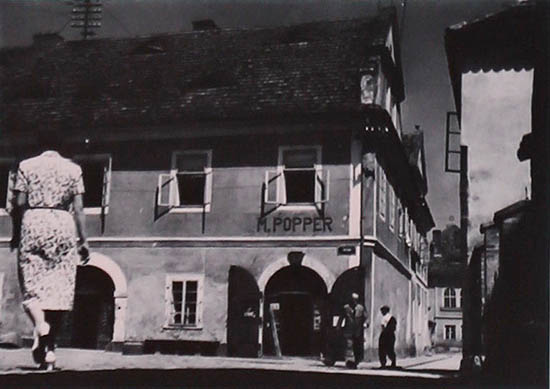
 The Jewish quarter of the town is a special architectural unit: a single large rectangular square surrounded by a closed row of façades of twenty houses, with two additional buildings on the square itself: the Baroque synagogue and the Popper House. A veritable planned quarter from the Renaissance, a tiny ideal city, a separate little closed world where time seems (somewhat) to have stopped.
The Jewish quarter of the town is a special architectural unit: a single large rectangular square surrounded by a closed row of façades of twenty houses, with two additional buildings on the square itself: the Baroque synagogue and the Popper House. A veritable planned quarter from the Renaissance, a tiny ideal city, a separate little closed world where time seems (somewhat) to have stopped.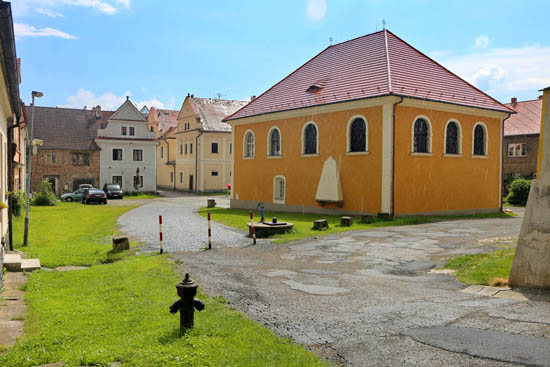
The whole quarter bears one single street name: Lokšany, which shows that it has traditionally been considered a single independent quarter. The name derives from the name of the lord of Březnice, Ferdinand von Loxan, who gave here land to the Jews to settle in 1562, at that time outside the city walls. Since the settlement and fate of the Jews – just like in most places in Eastern Europe – were closely connected with the owners of the town, it is worthwhile to quickly review the history of the latter.
 The castle in Březnice, as we have seen, belonged to the Buzic family in the Middle Ages. A lively trading town developed around it as early as the 13th century, thanks to its location on the so-called Golden Trail, one of the most important trade routes in medieval Bohemia, along which salt and other goods were carried from Passau through Prachatice to Prague. This branch of the Buzic family became extinct in the early 1400s, and the town was passed on to the superintendent of the royal mint, Peter Zmrzlík von Schweißing/Svojšín. It was him who, between 1411 and 1414, commissioned one of the most lavishly decorated Bohemian codices, the three-volume Bible of Litoměřice, the first surviving Bible translation in Czech. Over time, however, he lost the royal favor and his possessions due to his Hussite sympathies. In 1533, Březnice was given by Emperor Ferdinand I to his secretary, Georg von Loxan, marking the beginning of the most exciting, Renaissance, period of the castle’s history.
The castle in Březnice, as we have seen, belonged to the Buzic family in the Middle Ages. A lively trading town developed around it as early as the 13th century, thanks to its location on the so-called Golden Trail, one of the most important trade routes in medieval Bohemia, along which salt and other goods were carried from Passau through Prachatice to Prague. This branch of the Buzic family became extinct in the early 1400s, and the town was passed on to the superintendent of the royal mint, Peter Zmrzlík von Schweißing/Svojšín. It was him who, between 1411 and 1414, commissioned one of the most lavishly decorated Bohemian codices, the three-volume Bible of Litoměřice, the first surviving Bible translation in Czech. Over time, however, he lost the royal favor and his possessions due to his Hussite sympathies. In 1533, Březnice was given by Emperor Ferdinand I to his secretary, Georg von Loxan, marking the beginning of the most exciting, Renaissance, period of the castle’s history.Georg von Loxan – in the language of the Czechoslovaks, who adore translating the names of all their foreign-blooded aristocrats, Jiří z Lokšan – was Bohemian Vice-chancellor from 1530 and secretary and eminence grise to two kings. Nevertheless – or perhaps just because of this – it is just as difficult to collect reliable information about him as about other such eminences. He was born around 1491 in Silesia, where, however, no Loxan/Lokšan can be found. At a young age he probably toured Italy, where he became an educated humanist, and throughout his life corresponded with many humanist scholars under the name Georgius Loxanus.
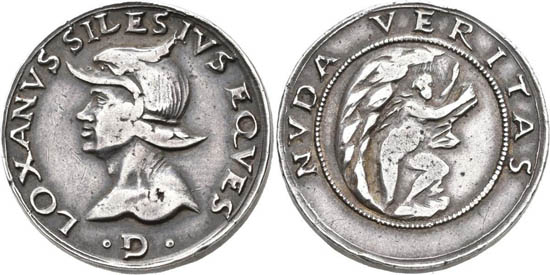 Georgius Loxanus’s two silver medals with humanist motti, and with the Renaissance visual topos of Truth coming to light on the reverse of the above one. It might have some autobiographical relevance.
Georgius Loxanus’s two silver medals with humanist motti, and with the Renaissance visual topos of Truth coming to light on the reverse of the above one. It might have some autobiographical relevance.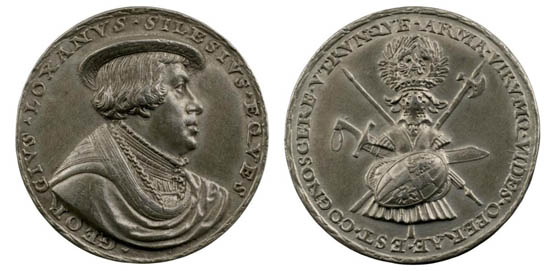
In 1523, he somehow became the secretary of King Louis II of Hungary. Then, after the lost battle of Mohács in 1526, where the king fell, he went into the service of Emperor Ferdinand I. Soon he became the emperor’s secretary and chief adviser, which Ferdinand honored with a number of gifts, including the title of Bohemia’s vice-chancellor, as well as the mining town of Kašperk in South Bohemia and Březnice. He had Březnice’s medieval castle rebuilt with Milanese masters in Renaissance style, but he did not live to see its completion in 1567, for he died in 1551. The construction was finished by his wife, Katherine von Loxan, daughter of the merchant-patrician Philipp Adler of Augsburg, who was only given a noble title after her husband. According to contemporaries, it was a great marriage of love.

This castle also became the nest of one of the great love stories of the Renaissance Hapsburgs. Katherine invited her niece, the beautiful Philippe Welser from Augsburg, who met here the second son of Emperor Ferdinand, Archduke Ferdinand II of Tyrol. In 1557, the couple married in secret in this castle, and in the following years they had four children. When the emperor learned of this, after his initial rage subsided, he only relented to approve the marriage if it remained a secret and the children did not inherit from their father. They had to be entered in the registers as foundlings, but at the same time they were allowed to bear the name “von Austria” and the title of Marquis – and later Prince – of Burgau.
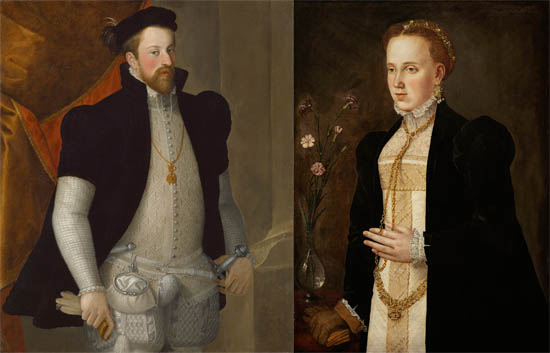 Archduke Ferdinand (Francesco Terzi, after 1557, Vienna, Kunsthistorisches Museum) and Philippe Welser (anonymous painter, 1557, Ambras Castle).
Archduke Ferdinand (Francesco Terzi, after 1557, Vienna, Kunsthistorisches Museum) and Philippe Welser (anonymous painter, 1557, Ambras Castle).In 1564, the Archduke was appointed governor of Tyrol. He moved with Philippe to Innsbruck, where they were followed by Aunt Katherine, who was buried there in 1580. Her sarcophagus is in the castle chapel. Březnice was taken over by her son, Ferdinand von Loxan, who, as a sober-minded humanist landowner, allowed Jews to settle next to this important town of the Golden Trail, yet outside the town walls, on an estate of the landlord. The new quarter was named Lokschan/Lokšany after the landowner. Ironically, the name of this noble family, the town from whose name originally derives is unknown, is today tied to a single existing settlement, which is a Jewish shtetl. Until the 20th century, the quarter was an independent settlement, with its own municipality and responsible only to the landlord, although it was practically in the heart of the old town: a single gate, the Judenbogen led from Březnice’s main square to the quarter.
Ferdinand von Loxan’s sons supported the Protestant orders during the anti-Hapsburg uprising of the Bohemian nobility, so their property was confiscated after the Battle of White Mountain (1620). It was donated in 1623 to the “Prague blood judge”, Přibík Jeníšek z Újezda (von Aujezd), who sentenced 26 members of the uprising to death and had them executed on the main square of Prague’s Old Town. A painting of the execution commissioned by the new owner can still be seen in Březnice Castle. This marks the beginning of the town’s Counter-Reformation era. Jeníšek had a chapel built for the castle, and in 1630 he founded a Jesuit mission in the town, which by 1640 grew into a college.
 He commissioned at Carlo Lurago the main square’s impressive Jesuit church in honor of St. Ignatius of Loyola and St. Francis Xavier, as well as the adjoining college, which, as we have seen, has taken over care of the pilgrimage site of the Holy Mountain in Příbram since 1647.
He commissioned at Carlo Lurago the main square’s impressive Jesuit church in honor of St. Ignatius of Loyola and St. Francis Xavier, as well as the adjoining college, which, as we have seen, has taken over care of the pilgrimage site of the Holy Mountain in Příbram since 1647.
The blood judge’s grandson, Johann Joseph von Aujezd, who ruled the town from 1677, was especially supportive of the Jews. In addition of a number of grants, the Jewish quarter was built in its present form in his time, in the early 1700s.
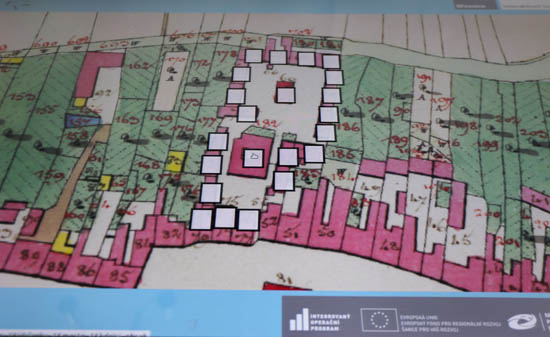 An interactive map of the Jewish quarter at the synagogue’s exhibit. The houses marked in red are the façade of the main square. In the middle of the large square of the Jewish quarter stand the large Popper House and the smaller synagogue.
An interactive map of the Jewish quarter at the synagogue’s exhibit. The houses marked in red are the façade of the main square. In the middle of the large square of the Jewish quarter stand the large Popper House and the smaller synagogue.The houses of the quarter were numbered in Roman numerals from I (the Popper House) to XXII. Number III was the rabbi’s house, XIV the kosher kitchen, and XXII was Philippe Welser’s own accommodation during the visits of the Archduke.

The synagogue was built in 1725. It burned down in April 1821, but was immediately rebuilt in its old form, with an enlarged women’s gallery (as was customary all over Europe in that period, when women began to more intensely attend the synagogue). The reconstruction was generously supported by the then landowner Kolowrat-Krakowsky family, so the pedestals of the columns of the Torah Ark are decorated with an arrow and a laurel wreath, elements of their coat of arms. The painting with the magnificent golden starry sky above the Torah Ark and the bimah was made in 1874 by Ladislav Kuba of Prague.
The Kolowrat-Krakowsky family inherited the town from the extinct Újezd family in 1727, shortly after the construction of the synagogue and the Baroque quarter. An interesting trivia is that in 1872, when the male branch of the Kolowrats died out, the town was inherited by the Hungarian Count Eduard Pálffy, whose mother was a Kolowrat girl. It will be confiscated from him by the Czechoslovak state in 1945, in terms of the Beneš decrees, which deprived the Germans and Hungarians of their citizen’s rights. (An important distinction: had he been deprived of it as an aristocrat, the family would have been able to get it back under the new Czech compensation laws. However, the ethnic groups affected by the Beneš decrees have received no compensation this far.)

Upstairs, at the level of the women’s gallery was the cheder, the Jewish elementary school. Here we now see an exhibition on the history of Jews in the region and the literature of Bohemian Jewry. After the cheder, the Jewish children continued their education in the Jesuit grammar school, which was German-language until 1901. From the windows on the three sides of the cheder, you can see almost the entire Jewish quarter, especially the Popper House, and the restaurant opposite it, now called Hospůdka u dědy Jehudy z Lokšany, ʻSmall restaurant of Uncle Judah of Lokšany’.

Beginning in the late 19th century, the Jews of Lokšany – just as Czech and Moravian Jews in general – gradually moved to large cities, and their rural centers became depopulated. As Jaroslav Polák-Rokycana writes in his 1934 study Geschichte der Juden in Březnice (Judenstadt Lokschan): “The «Lokschan» is in the process of extinction. It’s only a few more years, and this rural Bohemian ghetto will be a thing of the past.” He knew not how quickly he would be right. From Březnice, once home to hundreds of Jews, “only” twenty-eight people were deported to Theresienstadt and then to Auschwitz.
After the war, the synagogue was used as a storehouse, and the houses were occupied by new residents. The quarter was restored around 2010 as part of the “Deset hvězd” (Ten Stars) program, within which fifteen monuments from ten Bohemian Jewish centers were restored. Today, the synagogue can be visited every day, and the lively quarter faithfully preserves the atmosphere of a once-strange little microcosm.
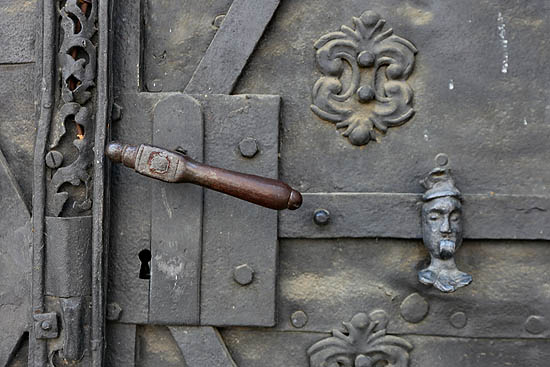
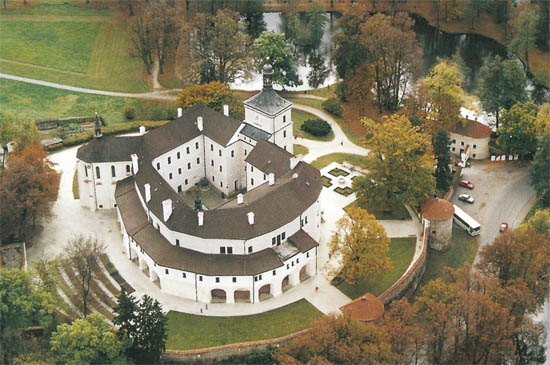
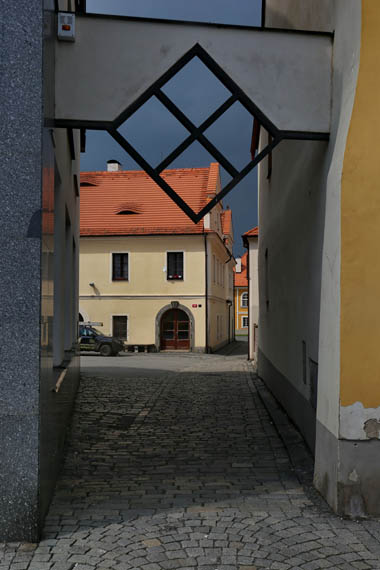
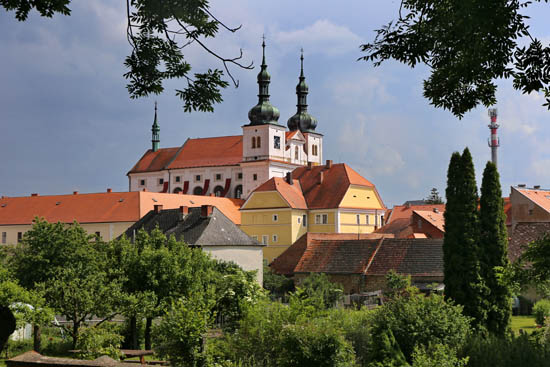

























































1 comentario:
Nice!
Publicar un comentario